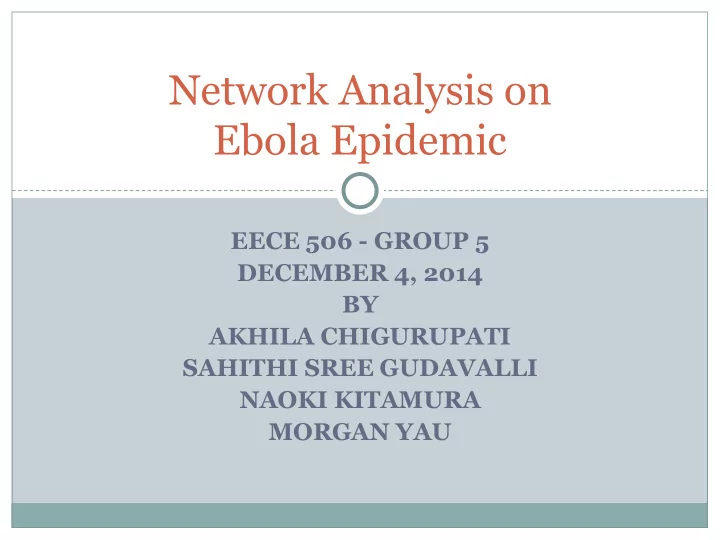

Network Analysis on Ebola Epidemic EECE 506 - GROUP 5 DECEMBER 4, 2014 BY AKHILA CHIGURUPATI SAHITHI SREE GUDAVALLI NAOKI KITAMURA MORGAN YAU
Outline ● Background ● Math Problem ● Assumptions ● Methodology ● SIS, SIR, and SEIR Models ● Calculation ● Simulation ● Results ● Future Improvements
Background ● Ebola Virus – EBOV, Zaire ebolavirus ● Infectious disease with high case fatality ● Zoonotic pathogen ● Symptoms ● Fever, Fatigue ● Vomiting, Diarrhea ● Hemorrhage Figure 1: Ebola virus
Math Problem ● Virus growth rate in spreading within a population Figure 2: Reported cases in West Africa from October 2014
Math Problem Figure 3: High contagion probability, virus spreads Figure 4: Low contagion probability, virus dies out
Assumptions ● Given data from Centers for Disease Control and Prevention (CDC) and the World Health Organization (WHO) is correct ● Incubation or latency period: 2 to 21 days ● Average time for death is 10 days after symptoms ● Has not evolved into airborne transmission ● There is no vaccine for this infectious disease ● For initial population, no individual diagnosed with symptoms
SIS Model ● Parameters: ○ S: Susceptible ○ I: Infectious ○ β: Contact rate ○ ϒ : Recovery rate ○ μ and μ*: Death/Birth rates ○ N: Total population Figure 5: SIS Model
Equations Involved ● Total Population: N=S(t)+I(t) ● Rate of susceptible over time: ● dS/dt = - βSI/N + (γ + µ)I ● Rate of infectious over time: ● dI/dt = βSI/N - (γ + µ)I Where, βSI/N indicates how infected people transfer the disease to susceptible ● Reproductive number R0=βI where, ○ R0 <1 :infection will decrease and become null ○ R0 >1 :disease is considered infectious
SIR Model ● Parameters: ○ Same variables used in SIS Model ○ R: Recovered with Immunity or removed due to death ○ α: Immunity loss rate Figure 6: SIR Model
Equations Involved ● N=S(t)+I(t)+R(t) ● dS/dt = - βSI/N + µ(N - S) + αR ● dI/dt =βSI/N - (γ + µ)I ● dR/dt = γI - µR - αR Where, βSI/N indicates how infected people transit the disease to susceptible ● Reproductive number is given by R0= β/γ+µ where, ○ R0 < 1 : infection will be cleared from the population. ○ R0 > 1 : pathogen is able to invade the susceptible population.
SEIR Model Figure 7: SEIR Model ● Parameters: ○ Same variables used in SIR Model ○ E: Individuals exposed to virus that don’t show symptoms and are not contagious ○ ε: Constant that determines how likely to become infectious after exposure per individual
Equations Involved
Calculations ● Given: ○ Data I(t) and R(t) from CDC ● From assumption: ○ μ=0 ○ α=0 ○ 1/ ε = 21 days ○ 1/ ɣ =10 days ○ R0=? ● R0= (β /γ)(1+q*γ/ ε ) ● *q is an arbitrary number from 0 to 1
Finding β ● Daily infectious rate: ● dI/dt=εE - (γ+μ)I=0 During Latency Period ● Cumulative latent data: ● E=γ*ε*I(t) ● Daily latent data: ● dE/dt=β(I+q*E) - ε*E ● Total infectious cases: ● I=σ*γ*E ● dE/dt=(β(ε*γ - ε))E <= Linear fit with Matrix ● Effective contact rate: ● β=Linear fit slope/(ε*γ - ε)
Results ● β=Linear fit slope/( ε*γ - ε )=0.1941 ● R0= (β /γ)(1+qγ/ ε ) ● q= (0 ≤ q ≤ 1) Figure 8: Reproductive number vs. weight factor
Results ● Reproduction Number: R0 = 2 ≤ R0 ≤ 6 Figure 9: Reproductive number values of infectious diseases
Results ● SIS Model doesn’t include recovery case ● SIR model is missing the consideration of a latency period ● On comparing the three models, SEIR model calculations were the most accurate ○ Incubation period ● Graph results Figure 10: Cumulative reported cases in West Africa
Future Improvements ● SEIR model limitation - Population size ● Using a continuous model ○ By integrating continuous variables over a time span in the above equations, we can obtain more realistic and feasible results. ● Use new parameters ○ Ebola virus evolves into different transmissions ○ There is a cure or vaccine discovered ● Environment conditions ○ Quarantine
Current News ● Current death toll is about 7,000 ● Setting up more Ebola Treatment Units in West Africa ● Vaccine currently in trial stage Figure 11: Participant receiving dose of vaccine
Programming Code
References ● [1] - http://media1.s-nbcnews.com/i/newscms/2014_40/586866/140727- ebola-jms-2109_1ed47d529151d5ad829c219cb5173ced.jpg ● [2] – http://www.cdc.gov/mmwr/preview/mmwrhtml/mm6343a3.htm?s_cid=mm6 343a3_w ● [3, 4] – http://www.cs.cornell.edu/home/kleinber/networks-book/networks- book-ch21.pdf ● [5, 6, 7] – https://wiki.eclipse.org/Introduction_to_Compartment_Models ● [8] - Programming Code (MATLAB) ● [9] - http://en.wikipedia.org/wiki/Basic_reproduction_number#cite_note-4 ● [10] – http://www.cdc.gov/vhf/ebola/outbreaks/2014-west-africa/cumulative- cases-graphs.html ● [11] - http://www.nih.gov/news/health/nov2014/niaid-28.htm
Questions?
Recommend
More recommend